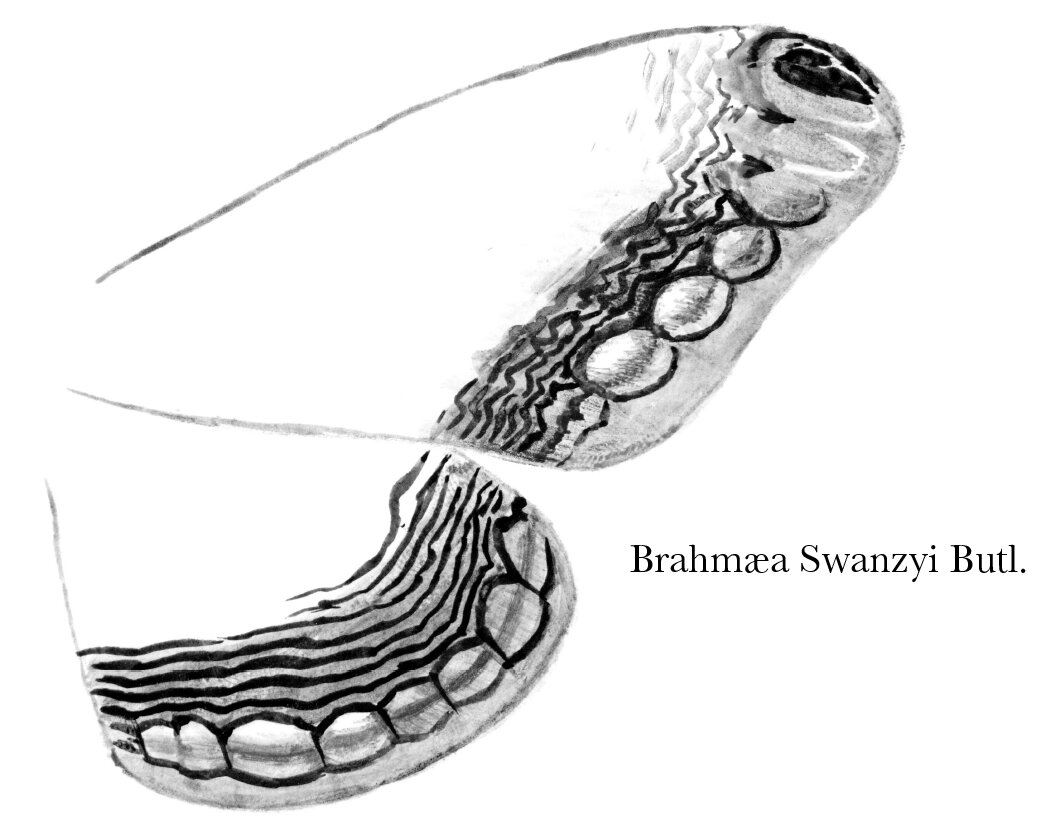From A. G. Butler 29 June 1871
17 Oxford Road, Ealing
29th. June 1871
Dear Sir
I am afraid you will be quite sick of me & my butterflies, but, whilst sketching the moth (of which part is given below) for one of my plates I was struck with the strong analogy between the marginal ocelli & those on the Argus-pheasant & I thought you might be interested by a sight of it;1

the gradations between the perfect & imperfect ocelli seem to point to the manner in which the former have been developed from the latter; all the species of Brahmæa are similarly ocellated, but B. Swanzyi & perhaps B. lucinæ* are the only species which exhibit an approach to the ball & socket ocellation.2
I think I may be wrong in my supposition respecting the identity of Elymnias Kamara & E. Ceryx, I find that Mr. Wallace has described a ♂ E. Ceryx which he says only differs from the ♀ in its darker colouring; still the ♀ of E. Kamara ought, judging by analogy, to be not unlike it.3
There is a curious example in the B. M. Coll. of ‘Natura facit saltum’4 a black form of Junonia Sophia Fabr. which looks exactly like a very small example of Panopea Lucretia Cramer; the ordinary colouring of J. Sophia is tawny, with brown or blackish bars across the wings; both species occur at Sierra Leone, yet it cannot be a case of mimicry since the black form is abnormal & the Panopea is itself a bad mimic of an Acrœa; I think however that such a variety, if necessary to the preservation of the species (i.e if J. Sophia were persecuted & P. Lucretia a protected form) might be retained & a mimic comparatively suddenly created.5
Many of Mr. Higgins’ ideas about the formation of markings on butterflies were based upon the notion that the wings of a butterfly were folded within the pupa, this is of course an error, the wing is of the same shape within the pupa as in the imago.6
I see that you often speak, in ‘Sexual Selection’, of the pugnacity of the ♂ Stickle-back during the breeding season7 I used to be much annoyed by it when a boy, for I always went to the Wandsworth-ponds with the intention of only bringing home the pretty Stickle-backs & I generally threw away most of the females; in two or three days all, or all but one of my fish were dead, many of them being struck in the eye by the spines of their companions.
Believe me to be | yours very sincerely | A G Butler.
*Brahmæa lucina is a species known only from Drury’s figure See P. Z. S. 1866. p. 121.8
Ch. Darwin Esqre. FRS &c
CD annotations
Footnotes
Bibliography
Butler, Arthur Gardiner. 1866. Note on the genus Brahmæa of Walker. [Read 27 February 1866.] Proceedings of the Zoological Society of London (1866): 118–21.
Butler, Arthur Gardiner. 1869. Catalogue of the diurnal Lepidoptera described by Fabricius in the collection of the British museum. London: Printed by order of the Trustees.
Descent: The descent of man, and selection in relation to sex. By Charles Darwin. 2 vols. London: John Murray. 1871.
Drury, Dru. 1770–82. Illustrations of natural History. Wherein are exhibited upwards of two hundred figures of exotic insects according to their different genera. 3 vols. London: printed for the author, and sold by B. White.
Higgins, Henry Hugh. 1868. On the colour-patterns of butterflies. Quarterly Journal of Science 5: 323–9.
Summary
Resemblance of ocelli, in a moth and the argus pheasant.
Mimicry.
Pugnacity of stickleback.
Letter details
- Letter no.
- DCP-LETT-7839
- From
- Arthur Gardiner Butler
- To
- Charles Robert Darwin
- Sent from
- Ealing
- Source of text
- DAR 89: 81–2
- Physical description
- ALS 4pp †
Please cite as
Darwin Correspondence Project, “Letter no. 7839,” accessed on 24 April 2024, https://www.darwinproject.ac.uk/letter/?docId=letters/DCP-LETT-7839.xml
Also published in The Correspondence of Charles Darwin, vol. 19


